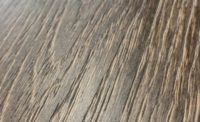Digital Printing Offers New Advantages for LVT Flooring

The floor is the largest surface in any given space, and it determines the entire look of an area—color, style, texture and pattern. Choosing a long-lasting surface, suited for its purpose and style is paramount to buying decisions. LVT fits many buyers’ most pressing needs, giving exceptional value by offering highly scratch and stain resistance with a flooring material that is also 100% waterproof.
The production process, however, is quite complex and time consuming with LVT’s multiple layers and multiple manufacturing stages. The design layer of LVT flooring is traditionally printed by analogue rotogravure print technology - high-speed, industrial printing presses that can produce as much as 93 million square meters per year. Very large print volumes and extremely long runs are needed to make the process viable because rotogravure cylinders and setup are very costly. Plus, setup can take several days to complete. Design possibilities are limited by width, which also defines the pattern repeatability. Additionally, investment in this type of equipment is very high.
New technology developed over the last decade is helping to convert multiple global LVT manufacturers from analogue to digital production. Digital print technology manufacturer Electronics For Imaging (EFI), for example, has installed several roll-to-roll UV LED inkjet printers from the company’s VUTEk product line at LVT manufacturers in the U.S. and Europe.
Digital printing systems offer important advantages over analog rotogravure technology. The cost of equipment and operating costs are significantly lower. They can offer much shorter production run lengths and therefore stock can be dramatically reduced or even eliminated. Design capabilities are endless with no pattern repeatability limitations and the cost of cylinders and setup are eliminated. Most importantly, digital UV LED inkjet printers can ensure very reliable color consistency over time, not just within the same run but weeks and years apart.
“As part of EFI’s strategy to address vertical markets and to facilitate the analogue-to-digital transformation of legacy systems, we have identified a real market need for a dedicated digital printer to answer the specialized requirements of the LVT industry,” said Tomer Ohavi, EFI Roll-to-Roll product marketing manager. The Fremont, California-based company completed a series of newer and faster VUTEk Q-line of roll-to-roll superwide-format graphics printers to make them specifically suitable for LVT production.
One important enhancement was made to the UV LED inks for the printers, with a new ink formulation and a proprietary clear bonding agent. Combined, the inks and bonding agent provide excellent adhesion and a very high peal strength, similar to that of analog systems. This ensures a very long product life that can be warranted by an LVT flooring manufacturer. Other changes include improved mechanical devices for protecting the delicate thin 50-70-micron substrate, an oxygen-free system for improved adhesion and a unique printing system algorithm.
This new technology is integrated into LVT manufacturing lines and has the ability to connect to the large media handling devices with full synchronization and in adherence to safety regulations.
The new inkjet technology available for LVT manufacturing represents an important opportunity for cost-effective, efficient manufacturing, and a transformation from analog to digital in LVT could mirror a transformation that has already taken place with ceramic tiles, a once-analog market that has embraced digital’s advantages to the point where commercial tile decoration industry-wide is now done almost entirely done with digital inkjet printing.
For more information, visit efi.com.
Looking for a reprint of this article?
From high-res PDFs to custom plaques, order your copy today!




